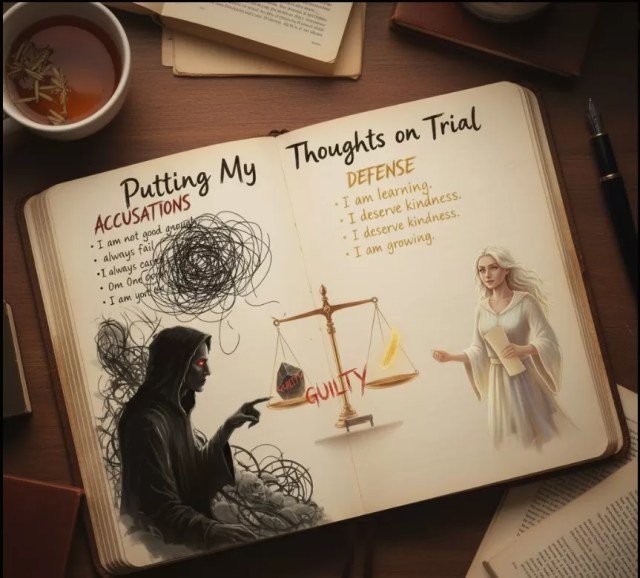
Post Disclaimer
The information on this website is designed to offer self-care tips and recommendations based on evidence-based research and literature from professionals in each field. It is not intended to diagnose or treat any specific medical condition. Please consult with your healthcare provider before making any health-related decisions.
Understanding the Roots of Mental Distress
Mental distress often arises from inner wounds, painful or confusing experiences that shape how we see ourselves and the world. These wounds influence our emotional triggers, automatic thoughts, and behavioral responses.
When something in your environment triggers a memory of past pain, it activates an emotional safety alarm. This alarm can create anxiety, shame, or self-criticism, not because you’re weak, but because your brain has learned to protect you through hyper-vigilance.
This process happens quickly:
- A trigger (thought, memory, or event) activates emotional pain.
- The brain attaches learned meaning, “I’m not safe,” “I’m not enough.”
- Emotional and behavioral responses follow automatically.
Healing begins when we face the pain with compassion and reframe the story that pain tells. One evidence-based approach for doing this is a cognitive restructuring technique called “Putting Your Thoughts on Trial.”
This guide will walk you through a step-by-step journaling process, and with practice, you can also apply it in real time whenever mental distress arises.
The Courtroom of the Mind
Inside your mind, imagine a courtroom. You are both the defendant and the jury, the one on trial and the one who decides what’s true.

In this inner courtroom, there are three key roles:
The Prosecutor
Represents your pain, fear, and self-critical thoughts. They pull from past experiences to argue that you’re flawed or unworthy. Their goal is to convict you of being “not enough.”
The Defense Attorney
Represents your inner wisdom, compassion, and healing self. Their goal is to show evidence that you are worthy of peace, forgiveness, and understanding.
The Jury
Represents your higher self, the part of you capable of empathy, balance, and truth. The Jury listens carefully, feels deeply, and ultimately decides what is fair. Over time, some Jury members begin to feel compassion for the defendant, for you.
This journaling practice helps you step into each role, creating emotional distance and clarity so you can see your thoughts objectively.

Step 1: Let the Prosecutor Speak
Give the Prosecutor the floor. Write freely and without judgment. The goal here is to see what your pain is trying to prove.
Prompts:
- What emotion or pain are you feeling right now?
- Name the feeling (I feel worthless, rejected, or like a failure.)
- What story or belief is the Prosecutor presenting as “evidence”?
- What memories, thoughts, or experiences are being used to prove this guilt?
Example:
Emotion: Shame
Thought: “I always mess things up.”
Evidence: “I failed my last relationship, I got fired once, and people get tired of me.”
Let the Prosecutor finish their argument. Don’t argue back yet, just record the story.
Step 2: Invite the Defense Attorney
Now allow your Defense Attorney, your compassionate, wise self, to respond. This voice doesn’t erase pain but provides context, balance, and truth.
Prompts:
- What evidence challenges or reframes the Prosecutor’s claims?
- What facts or experiences have been ignored or exaggerated?
- How would the Defense interpret your pain with empathy and compassion?
- What would this voice say if its goal were to restore peace, not assign blame?
Example:
“Yes, I’ve made mistakes, but that doesn’t make me a failure. I’ve learned from them. I’ve shown resilience by getting back up. I’ve done many things right that the Prosecutor ignored.”
The Defense Attorney’s goal is not to win by denial; it’s to reveal the fuller truth and guide you toward self-understanding.
Step 3: The Jury Deliberates
Step back and let your inner Jury, your higher observing self, deliberate. This is the moment of compassionate perspective-taking.
Prompts:
- What would the compassionate Jury members say to you?
- How might they view your situation with empathy and understanding?
- If they believed your healing mattered more than your guilt, what would their verdict be?
Example:
“We see that you’ve suffered deeply. You’ve been carrying beliefs that weren’t fully true. You are not guilty of being broken, you are human, healing, and learning to care for yourself.”
Step 4: The Verdict: Reframing and Release
The final step is integration, discovering the balanced truth, and rewriting the belief.
Prompts:
- What truth feels balanced, compassionate, and healing?
- What belief do you want to carry forward?
- What action, affirmation, or self-care step would honor this verdict?
Example:
“The truth is I’ve been hard on myself because I care deeply. But I am not guilty of being unworthy. I am worthy of love and peace.
My new belief: ‘I am learning, growing, and deserving of compassion.’”
Optional Reflection Questions
- What surprised you most about what each side said?
- Which voice tends to dominate your inner dialogue, the Prosecutor or the Defense?
- How can you strengthen your Defense Attorney’s voice daily?
- What does your compassionate Jury want you to remember next time pain arises?
Closing Reflection
When you put your thoughts on trial, you stop letting pain act as both judge and jury. You create space between emotion and truth, a space where compassion, balance, and healing can take root.
With practice, your Prosecutor grows quieter, your Defense Attorney grows stronger, and your Jury becomes more compassionate. That’s the essence of emotional justice, not punishment, but peace.


